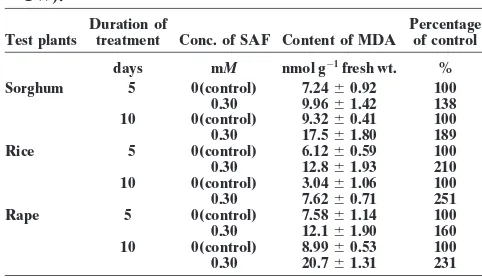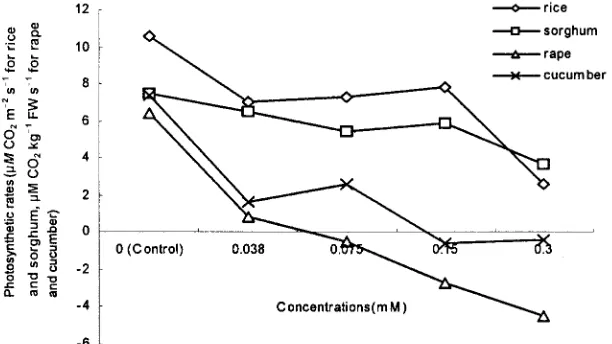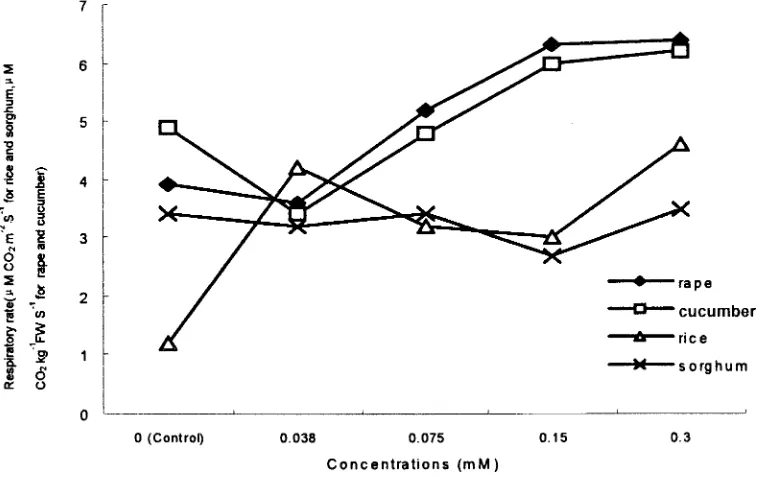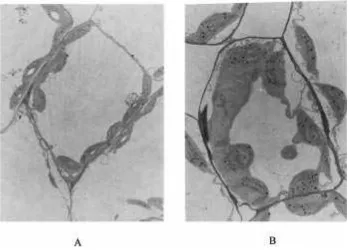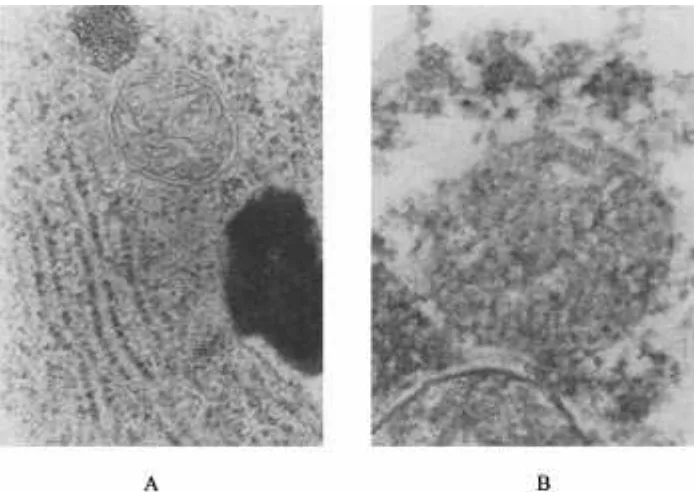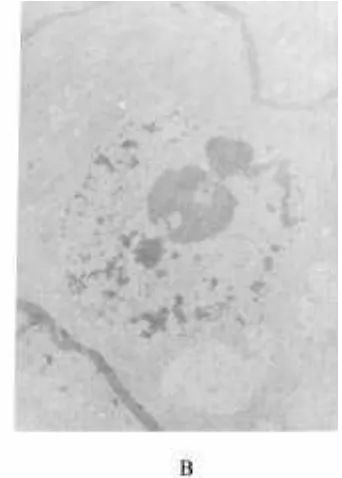of Secalonic Acid F on Higher Plants
Ren Sen Zeng,* Shi Ming Luo, Yue Hong Shi, Mu Biao Shi, and Cong Yong Tu
ABSTRACT phenolic acids. All of these have inhibitory activity, and
most of them produce different biological lesions (Ein-Our previous work indicated that secalonic acid F (SAF) was the
hellig, 1995). major allelochemical produced by Aspergillus japonicus. Studies
showed that SAF markedly inhibited the seedling growth of sorghum Secalonic acids, a series of ergochrome pigments, exist (Sorghum vulgarePers.), hairy beggarticks (Bidens pilosaL.), and in a group of food-born fungal metabolites (Betina, barnyardgrass (Echinochloa crus-galli(L.) Beauv.). It significantly 1984). These fungi produce one or more secalonic acids reduced the activities of superoxide dismutase (SOD) and peroxidase when they grow on rice (Oryza sativa L.), corn (Zea (POD) at a concentration of 0.3 mM. Secalonic acid F enhanced maysL.), and rye (Secale cerealeL.) (Kurobane et al., malondialdehyde (MDA) contents, but it lowered the content of
chlo-1979). Secalonic acid A is a highly potent phytotoxic rophyll (CHL) a and b as well as the photosynthetic rates of tested
compound that is isolated from several fungi such as plants. Respiration, membrane permeability, and abscisic acid (ABA)
Aspergillus aculeatus(Andersen et al., 1977) and Pyre-content increased after treatment with SAF, but the reduction activity
nochaeta terrestris(Steffens and Robeson, 1987). Seca-of the root system was lowered. There is no remarkable change in
lonic acid D, a metabolite produced byPenicillium ox-the soluble proteins of plants that are treated with SAF. Transmission
electron microscope (TEM) observations showed that treated plants aium, causes storage rot of cucumber (Cucumis sativus exhibited amorphous mitochondria without integral membranes and L.) and tomato (Lycopersicon lycopersicumL.) (Jarvis swelling chloroplasts without membranes in a disorderly arrangement. et al., 1990). It is an inhibitor of protein kinase C and The SAF treatment also damaged the stratiform structure of the cyclic AMP-dependent protein kinase (Wang et al., chloroplasts and the membranes and structure of the nuclei. These
1996). Secalonic acid F was originally isolated from results suggest that SAF may weaken the protective ability of plant
Claviceps purpurea(Aberhart et al., 1965). Our previous tissues against membrane lipid peroxidation and damage the whole
work indicated that SAF was a major allelochemical membrane system of plants, resulting in the ultrastructure destruction
produced by A. japonicus(Zeng et al., 2001). Details of chloroplasts, mitochondria, and nuclei. Cell ultrastructure
destruc-are needed about the mode of action of secalonic acids tion causes a reduction of photosynthesis and root activities and an
increase in respiration. These abnormal physiological processes con- against higher plants to deepen the understanding of tribute to the inhibition of plant growth. the chemical interaction between fungi and higher plants. Our objective was to determine the physiological and biochemical mechanism of allelopathy of SAF.
A
llelopathy is mediated by many types ofcom-pounds with different sites and modes of
biochemi-MATERIALS AND METHODS cal action (Rice, 1984). It was originally defined as the
Secalonic Acid F biochemical interactions between plants of all kinds,
including the microorganisms that are typically placed Secalonic acid F was isolated as yellow needles from the in the plant kingdom (Molisch, 1937). Einhellig (1986) fermentative hyphae of A. japonicus. Its purity was deter-pointed out that a clear insight into the precise physio- mined by 1H nuclear magnetic resonance data recorded on logical perturbations caused by allelochemicals had not a Bruker AC-P200 spectrometer (200 MHz) using cadmium chloride (CDCl3) as a solvent and tetramethyl silicane as an been obtained, and it might be emphasized that much
internal standard. additional information is needed. One of the most
signif-Secalonic acid F was dissolved in a 1.5 g L21 dimethyl icant limitations that have curtailed attempts to
investi-formamide (DMF) solution. Ultraviolet absorption of SAF gate how allelochemicals alter growth is the lack of
dissolved in 10 g L21DMF did not change compared with sufficient quantities of a compound necessary to study
SAF dissolved in a 950 g L21 ethanol (C
2H5OH) solution. the effects on physiological processes and cellular mech- A preliminary study showed that DMF did not affect the anisms (Einhellig, 1995). Several modes of action for phytotoxicity of SAF (Zeng et al., 2001).
allelochemicals are involved in the inhibition and modi-fication of plant growth and development (Einhellig,
Plant Materials 1986). Allelochemicals may be selective in their action,
or plants may be selective in their responses. These The seeds of rape (Brassica campestrisL.), cucumber, corn, considerations are complicated further by the presence and sorghum were obtained from a local market in Guang-of more than one active compound from a single plant zhou, China. The seeds of hairy beggarticks and barnyardgrass were collected from the campus of South China Agricul-or fungus. FAgricul-or example, SAgricul-orghum species contain
cyano-tural University. genic glycosides, tannins, flavonoids, and a series of
Inst. of Tropical & Subtropical Ecology, S. China Agric. Univ.,
Wu-Abbreviations:ABA, abscisic acid; DMF, dimethyl formamide; EC, shan, Guangzhou, 510642. P.R. China. Received 29 Nov. 1999.
*Corre-electric conductivity; ELISA, enzyme-linked immunosorbent assay; sponding author ([email protected]).
MDA, malondialdehyde; POD, peroxidase; SAF, secalonic acid F; SOD, superoxide dismutase; TEM, transmission electron microscope. Published in Agron. J. 93:72–79 (2001).
Table 2. Effects of different concentrations of secalonic acid F Table 1. Effects of secalonic acid F (SAF) on seedling growth of
sorghum, barnyardgrass, and hairy beggarticks (cm). (SAF) on the content of malondialdehyde (MDA) (nmol g21
FW).
Sorghum Barnyardgrass Hairy beggarticks
Duration of Percentage
Root Shoot Root Shoot Root Shoot Test plants treatment Conc. of SAF Content of MDA of control Conc. of SAF length length length length length length
days mM nmol g21fresh wt. %
mM cm
Sorghum 5 0(control) 7.2460.92 100
0 (Control) 3.2b 7.4a 3.8a 3.7a 4.0a 3.7a 0.30 9.9661.42 138
0.038 4.3a 7.8a 2.5b 3.0ab 2.3b 2.2b 10 0(control) 9.3260.41 100
0.075 1.6c 3.8b 2.3b 2.4b 0.9c 0.4c 0.30 17.561.80 189
0.15 1.6c 3.3b 0.4c 1.6c 0.6c 0.3c Rice 5 0(control) 6.1260.59 100
0.30 0.9c 2.9b 0.1c 0.8d 0.3c 0.2c 0.30 12.861.93 210
10 0(control) 3.0461.06 100
Numbers with different letters within a column refer to a significant
0.30 7.6260.71 251
difference at the 0.05 level according to Duncan’s multiple range test.
Rape 5 0(control) 7.5861.14 100
0.30 12.161.90 160
10 0(control) 8.9960.53 100
Bioassays
0.30 20.761.31 231
The seeds were germinated before being cultivated in a SAF solution. Ten seeds each were placed in 50-mL beakers
to another plate with different concentrations of SAF solution. and kept in 5 mL of different concentrations of SAF solutions,
After another 6 d of incubation, 0.05 g of leaves were harvested with a temperature of 288C and a 12-h photoperiod. The
to be extracted with a 10-mL mixture of acetone (C3H6
O)-amount of photosynthetically active radiation during the
day-anhydrous ethanol water (45:45:10 V/V) for 48 h in the dark time was 250mmol photons m22s21. After 4 d, the root and
at 4 to 58C. The absorption of each CHL extract was read shoot lengths were measured. All treatments consisted of at
using a spectrophotometer at 665 and 649 nm, and the values least three replications.
for each CHL a, CHL b, and total CHL were determined according to the method of Arnon (1949). There were three
Reduction Activities in Roots replications for each treatment, and the experiment was
dupli-cated. Data were subjected to an analysis of variance, and The method used for measuring the root reduction activities
significant difference was determined by nonoverlapping con-has been described by Zhang (1990). The roots (0.5 g) were
fidence intervals atP50.05. washed, blotter-dried, weighted, and soaked in a 10-mL
mix-Six-day-old seedlings were placed in one-half strength ture of 5 mL of 4 g L212,3,5-triphenyl tetrazolium chloride
Hoagland solution with 0.038, 0.075, 0.15, and 0.3 mMSAF and 5 mL of a PO4buffer (pH 7) in darkness at 378C for 1 h.
solution to incubate for 5 and 10 d in a greenhouse. The rate Thereafter, 2 mL of 1.0Msulfuric acid (H2SO4) was added
of photosynthesis was measured at 200mmol photons m22s21
to stop the reaction. The roots were removed, washed with
and 258C using the Li-Cor LI-6200 Portable Photosynthesis distilled water, blotter-dried, and ground with two portions
System. The respiratory rate was measured in the dark. of 3 to 4 mL of ethyl acetate (C4H8O2) in a mortar and pestle.
The extract was filtrated through filter paper. The volume was
made up to 10 mL and the optical density of the formazan Malondialdehyde, Soluble Protein, and Activities extract was read at 485 nm on the ultraviolet spectrophotome- of Superoxide Dismutase and Peroxidase ter (756 MC). An enzyme unit was defined as the quantity
The plant material preparation for MDA measurement was (mg) of tetrazolium chloride reduction per hour on a per gram
the same as that used for CHL extraction. The receptor plants root (fresh wt.) basis.
included sorghum, rice, and rape. Leaf tissue (1 g) was ground and homogenized with a chilled mortar and pestle in 5 mL of
Chlorophyll Content and Photosynthetic
a chilled 0.05-MPO4buffer (pH 7.8) at 1 to 58C. The
homoge-and Respiratory Rates nate was strained through four layers of cheesecloth. The
liquid suspension was centrifuged at 1900 g for 20 min. After The sorghum seedlings that were incubated at 288C under
250mmol photons m22s21artificial light for 6 d were removed centrifugation, the supernatant was used for measurement of
Fig. 2. Effects of different conc. of secalonic acid F (SAF) on the chlorophyll (CHL) content of sorghum seedling.
MDA using the method described by Zhao et al. (1994). The conductivity meter (DDS-11A). Thereafter, the seedlings and their solution were heated to 1008C for 20 min. After the supernatant preparation for SOD and POD activity
measure-ment was the same as that used for MDA measuremeasure-ment. SOD solution cooled, the EC was analyzed again. activity was measured using the method described by
Gianno-politis and Ries (1977). POD activity was determined using Electron Microscopy the method described by Kraus and Fletcher (1994). Soluble
Six-day-old seedlings of corn, rice, and rape were cultured protein was assayed using the method of Bradford, with bovine
in 0.3 mMSAF aqueous solution for another 5 d. The root serum albumin as the standard (Bradford, 1976).
tips (3 mm) and leaf segments were fixed for 3 h in 30 g L21glutaraldehyde in a 0.1-mMsodium phosphate (Na
3PO4) Abscisic Acid Content buffer (pH 7). They were postfixed for 4 h in 10 g L21osmic
acid in a 0.1-mMPO4buffer (pH 7.2) and then embedded.
The abscisic acid content was measured using the method
After being fixed, the specimens were examined on a of enzyme-linked immunosorbent assay (ELISA). The ELISA
JEM1010 TEM. was produced by the Nanjing Agricultural University Plant
Hormone Laboratory of China. The product was suitable to
measure hormones that belonged to the sopentenyladenosine Statistics
group. The experimental procedures followed the method
de-The data from each experiment were subjected to an analy-scribed by Zhang (1990).
sis of variance, with the significant differences among means identified by Duncan’s multiple range test (P,0.05).
Electric Conductivity
Six-day-old seedlings of rice, rape, cucumber, and sorghum
RESULTS AND DISCUSSION
were cultured in 20-mL SAF aqueous solutions for another 5 d.Our previous work showed that SAF inhibited the The control seedlings were cultured in 10 g L21DMF solution.
seedling growth of rape, radish (Raphanus sativus L.), Then 0.2-g seedlings were rinsed with distilled water and
sus-and rice (Zeng et al., 2001). It also inhibited the seedling pended in 30 mL of deionized water under reduced pressure
for 1 h. The electric conductivity (EC) was analyzed using a growth of barnyardgrass and hairy beggarticks at a
Fig. 4. Effects of different conc. of secalonic acid F (SAF) on respiratory rates.
However, SAF significantly reduced the CHL content at centration of 0.038 mM(Table 1). Even at a
concentra-a concentrconcentra-ation of 0.075 mM. The content of CHL a tion of 0. 47 3 1023 mM, SAF reduced the root and
and b were only 49.6 and 36.8% of the control, respec-shoot growth of barnyardgrass seedlings by 15.8 and
tively, at a concentration of 0.15 mMSAF. The seedling 19.9%, respectively. It also stimulated the root growth
leaves became yellow at this concentration. The results of sorghum at a concentration of 0.038 mMbut inhibited
were consistent with the effects of SAF on seedling the seedling growth at a concentration$0.075 mM. This
growth (Table 1). indicated that low concentrations of SAF would
stimu-Figure 3 showed that SAF treatment reduced the late the seedling growth of some plants.
photosynthetic rate. For dicotyls such as rape and cu-cumber, the reduction was drastic. The photosynthetic
Effects on Root Activities
rates of rape and cucumber were only 12.5 and 21.6% The root reduction activities of rice seedlings were of the control, respectively, at a concentration of 0.038 significantly reduced when they were cultured in a SAF mM SAF. When the SAF concentration was .0.075 aqueous solution. The inhibition was 14.7 and 39.1% at mM, the photosynthetic rates of rape were negative. concentrations of 0.038 and 0.075 mMSAF, respectively This meant that the CO
2consumption of photosynthesis (Fig. 1). At a concentration of 0.6 mM SAF, the rice was less than the CO
2 production of respiration. The root reduction activities were very low—only 18.9% of photosynthetic rate of cucumber was negative at a con-the normal seedling roots. centration of 0.15 mMSAF. The photosynthetic rate of sorghum did not significantly decrease until the SAF
Effects on Chlorophyll Content and
concentration reached 0.075 mM, and it was 50% of thePhotosynthetic and Respiratory Rates
control at a SAF concentration of 0.30 mM. No negative photosynthetic rate of sorghum was observed. The pho-Secalonic acid F obviously increased the CHL contentof sorghum at a low concentration of 0.038 mM(Fig. 2). tosynthetic rate not changing drastically in sorghum may
Table 3. Effects of secalonic acid F (SAF) on the activities of superoxide dismutase (SOD), peroxidase (POD) and the content of soluble proteins.
Content of soluble
Test plants Conc. of SAF Activities of SOD Activities of POD proteins
mmol min21g21
mM fresh wt. mg g21FW min21 mg g21FW
Sorghum 0 94.368.2 9.361.3 6.862.3
0.30 74.0*65.6 7.3*62.6 6.061.4
Rice 0 90.769.3 42.462.2 8.761.7
0.30 26.0**64.1 34.7*61.9 7.762.3
Rape 0 11166.3 16.862.2 8.462.2
0.30 56.7**68.2 15.2*62.8 5.3*61.3
Table 4. Effects of secalonic acid F (SAF) on membrane perme-
Effects on Superoxide Dismutase, Peroxidase,
ability.
and Soluble Protein
Test plants Conc. of SAF EC before boiling EC after boiling
The SOD and POD activities of all three of the tested mM mS cm21 crops significantly declined when they were treated with
Rice control 9.761.5 38.461.4 0.3 mMSAF (Table 3). The SOD activities of rape and
0.3 12.461.3 53.362.5
rice decreased by 49 and 71%, respectively, while they
Rape control 13.361.6 89.062.1
0.3 16.961.1 142.066.0 decreased by only 22.5% for sorghum. The POD activi-Cucumber control 9.160.4 48.061.7 ties of sorghum decreased by 21%. The soluble protein
0.15 24.561.2 50.062.7
content of rape was significantly reduced by SAF
treat-Sorghum control 4.760.5 34.260.9
0.15 8.560.6 31.161.5 ment, whereas that of rice and sorghum did not change significantly. A reduction of SOD and POD activities may cause a mass accumulation of active O2 in plant leaves, which leads to membrane lipid peroxidation be the result of the C-4 metabolic pathway of the plant.
(Keppler and Novacky, 1987). Membrane lipid peroxi-The photosynthetic rate of rice decreased by 34 and
dation results in the destruction of membrane systems 75.5% at concentrations of 0.038 and 0.3 mM SAF,
(Song et al., 1996; Keppler and Novacky, 1989). respectively. No negative photosynthetic rate was
ob-served for rice.
Effects on Abscisic Acid Content
Figure 4 shows that the respiratory rate of rape
in-After 5 d of treatment with SAF, the ABA content creased at a concentration of 0.075 mMSAF. When the
of rice seedlings increased by 158%. When rice seedlings concentration was 0.15 mMSAF, the respiratory rate of
were treated with SAF for 10 d, the ABA content in-rape was 161.5% of control. The respiratory rate of
cu-creased by 230.5%. This indicated that the ABA content cumber significantly increased at concentrations of 0.15
in rice seedlings would increase with longer SAF and 0.30 mMSAF while the respiratory rate of sorghum
treatments. changed little. The respiration of rice was sensitive to
SAF at a concentration of 0.038 mM, increasing by
Effects on Membrane Permeability
250%, but did not change drastically, even at aconcen-Table 4 shows that the EC of rice and rape increased tration of 0.3 mMSAF.
either before boiling or after boiling. The EC of rape increased by 59.6% after boiling compared with the
Effects on Malondialdehyde
control. And the EC of cucumber and sorghum in-creased by 169.2 and 80.9%, respectively, before boiling The MDA content of rape, rice, and sorghum thatbut changed little after boiling. were treated with 0.3 mM SAF for 5 d increased by
60, 110, and 38%, respectively (Table 2). After a 10-d
Effects on Cell Ultrastructure
treatment, it increased by 131, 151, and 89%. The MDAcontent of the three crops showed the similar ascending The normal leaf cell structure and chloroplast ar-rangement of rape are shown in Fig. 5A. The chloro-tendency when the treatment duration was longer.
Fig. 6. Leaf cell structure and chloroplasts of rice.
plasts are lined closely to the cell periphery. However, spicuous and incompact—the nucleolus appears to be less apparent.
the leaf cells of the treated rape have swelling chloro-plasts that were in a messy distribution (Fig. 5B). Some
chloroplasts combined and separated from the cell pe-
CONCLUSIONS
riphery. Figure 6 shows that chloroplasts of rice that
Results indicate that SAF produced byA. japonicus
were treated with 0.3 mMSAF lost their membrane—
interferes with many physiological and biochemical their stratiform structure became inconspicuous. Figure
processes of higher plants. It significantly reduced the 7 indicates that the mitochondria of treated rice roots
activities of SOD and POD at a concentration of 0.3 swelled and lost their membranes—their stratiform
mM. Secalonic acid F enhanced MDA contents, but it structure became indistinct. Figure 8 indicates that the
nuclei membranes of treated corn roots became incon- lowered the contents of CHL a and CHL b as well as
Fig. 8. Nuclei structure of corn roots.
the photosynthetic rates of the tested plants. Respiration plant growth. Although the exact sequence of SAF ac-tions remains uncertain, these data suggest that some and ABA content increased after treatment with SAF.
When cucumber and sorghum were treated with 0.15 effects are more potent than others. The action of SAF on membranes is essentially responsible for the disrup-mM SAF, their membrane permeability increased.
When rice and rape were treated with 0.3 mMSAF, their tion of most other processes. This is consistent with the mode of action of phenolic acids (Einhellig, 1995). cells would lose water, which resulted in the increase of
EC after boiling. Secalonic acid F lowered the reduction
activity of the root system, but the plants that were ACKNOWLEDGMENTS
treated with SAF experienced no significant change in
We thank the National Natural Science Foundation of
soluble proteins. China (39770136), Guangdong Provincial Natural Science
Most of the tested physiological and biochemical Foundation of China (990682, 960426), and the National Labo-processes of dicotyls such as rape and cucumber were ratory of Elemento-Orangic Chemistry, Nankai University, more severely affected by treatment with SAF than for their financial support.
monocotyls such as sorghum, which was least affected.
This agreed with the bioassay results and the observa- REFERENCES
tion that the SAF producing fungus,A. japonicus, often
Aberhart, D.J., Y.S. Chen, P.D. Mayo, and J.B. Stothers. 1965. Mould contaminated the seeds of some dicotyls and caused metabolites: The isolation and constitution of some ergot pigments. inhibition of seed germination and seedling growth. The Tetrahedron 21:1417–1432.
Andersen, R., B. George, B. Kobbe, and A.L. Demain. 1977. Secalonic results indicate thatA. japonicusand its allelochemical
acids D and F are toxic metabolites ofAspergillus aculeatus. J. SAF are selective.
Org. Chem. 42:352–353.
The TEM observations showed that treated plants Arnon, D.I. 1949. Copper enzymes in isolated chloroplasts. Polyphe-exhibited amorphous mitochondria without integral noloxidase in Beta vulgaris. Plant Physiol. 24:1–15.
membranes and swelling chloroplasts without mem- Betina, V. (ed.) 1984. Mycotoxins: Production, isolation, separation, and purification. Elsevier Sci. Publ., New York.
branes that were in a disorderly arrangement. The SAF
Bradford, M. 1976. A rapid and sensitive method for the quantitation treatment also damaged the stratiform structure of the
of microgram quantities of protein utilizing the principle protein-chloroplasts and the membranes and structure of the dye binding. Anal. Biochem. 72:248–254.
nuclei. Einhellig, F.A. 1986. Mechanisms and modes of action of
allelochemi-cals. p. 171–187.InA.R. Putnam and C.S. Tang (ed.) The science Obtained results suggest that SAF may weaken the
of allelopathy. John Wiley & Sons, New York. protective ability of plant tissues against membrane lipid
Einhellig, F.A. 1995. Mechanism of action of allelochemicals in allelo-peroxidation and damage to the cell membrane system
pathy. p. 96–116.InInderjit et al. (ed.) Allelopathy: Organisms, (Kraus and Fletcher, 1994; Song et al., 1996), resulting processes, and applications. Am. Chem. Soc. Symp. Ser. 582. Am. in an increase of membrane permeability (Keppler and Chem. Soc., Washington, DC.
Giannopolitis, C.N., and S.K. Ries. 1977. Superoxide dismutase. Oc-Novacky, 1989) and ultrastructure destruction of
chloro-currence in higher plants. Plant Physiol. 59:309–314. plasts, mitochondria, and nuclei. Ultrastructure
destruc-Jarvis, W.R., S.D. Barrie, and J.A. Traquair. 1990. Morphological and tion causes a reduction of photosynthesis and root activi- chemical studies ofPenicillium oxalicum, newly identified as a ties as well as increase in respiration. These abnormal pathogen on greenhouse cucumbers. Can. J. Bot. 68:21–25.
lipid peroxidation during bacteria-induced hypersensitive reaction. Song, F.M., Z. Zheng, and G.X. Chun. 1996. Role of active oxygen and membrane lipid peroxidation in plant–pathogen interactions. Physiol. Mol. Plant Pathol. 30:233–245.
Keppler, L.D., and A. Novacky. 1989. Changes in cucumber cotyledon (In Chinese). Plant Physiol. Commun. 32:377–385.
Steffens, J.C., and D.J. Robeson. 1987. Secalonic acid A, a vivotoxin membrane lipid fatty acids during paraquat treatment and a
bacte-ria-induced hypersensitive reaction. Phytopathology 79:705–708. in pink root-infected onion. Phytochemistry 26:1599–1602. Wang, B.H., G.M. Polya, and B.H. Wang. 1996. The fungal teratogen Kraus, T.E., and R.A. Fletcher. 1994. Paclobutrazol protects wheat
seedlings from heat and paraquat injury, is detoxification of active secalonic acid D is an inhibitor of protein kinase C and of cyclic AMP-dependent proteinkinase. Planta Med. 62:111–114. oxygen involved? Plant Cell Physiol. 35:45–52.
Kurobane, I., L.C. Vining, and A.G. Mclnnes. 1979. Biosynthetic Zeng, R.S., S.M. Luo, M.B. Shi, Y.H. Shi, Q. Zeng, and H.F. Tan. 2001. Allelopathy ofAspergillus japonicus on Crops. Agron. J. relationships among the secalonic acids: Isolation of emodin,
endo-crocin, and secalonic acids fromPyrenochaetaandAspergillus acu- 93:60–64 (this issue).
Zhang, Z.L. 1990. Experiments and methods in plant physiology. (In leatus. J. Antibiot. 32:1256–1266.
Molish, H. 1937. Der Einfluss einer Pflanze auf die andere-Allelopa- Chinese). 2nd ed. Higher Educ. Press, Beijing.
Zhao, S.J., C.C. Xu, Q. Zou, and Q.W. Meng. 1994. Improvements thie, Gustav. Fischer. Verlag, Jena.
Rice, E.L. (ed.) 1984. Allelopathy. 2nd ed. Academic Press, Or- of method for measurement of malondialdehyde in plant tissue. (In Chinese). Plant Physiol. Commun. 30:207–210.
lando, FL.
Soil: Environmental Effects on Allelochemical Activity
Inderjit*
ABSTRACT of plant species (allelopathy), (ii) availablity of soil
inor-ganic ions, and (iii) soil microbial ecology (Inderjit and To exert phytotoxic effects on other plant species, chemicals may
Weston, 2000). Several techniques have been proposed have to move to the roots of the target plant through the soil. However,
during movement, abiotic (physical and chemical) and biotic (micro- and tested to study the effects of root exudates (Inderjit bial) soil barriers can limit the phytotoxicity of chemicals in terms of et al., 1999b). Tang and Young (1982) proposed a quality and quantity required to cause injury. Organic matter, reactive method to collect allelopathic compounds from the un-mineral surfaces, ion exchange capacity, inorganic ions, and abiotic disturbed root system of bigalta limpograss [Hemarthria and biotic factors of soil environment significantly influence
allelo-altissima(Poir.) Stapf & C.E. Hubb.]. Stolon cuttings chemical activity. In this article, the significance of soil in laboratory
of bigalta limpograss were washed and treated with 5% and field studies on allelochemical interference is discussed.
(v/v) Clorox (sodium hypochlorite) before planting in the pots. The pots were filled with crushed basaltic rocks and sand/rock mixtures (2:1, v/v). The soils from the
S
oilis a living biological system that provides habitatrhizosphere of bigalta limograss were not selected as a for microorganisms, e.g., bacteria, fungi,
actino-medium in the study, and this might have significantly myctes, algae, and protozoa (Wild, 1996). In many cases,
influenced the collection of allelochemicals. Studies con-allelochemicals move through soil and they may be
ducted without involving soil may not reproduce soil transformed during movement, metabolized by soil
mi-conditions that influence expression of allelochemicals crobes, or bound to soil organic matter. Microbes may
in nature. toxify or detoxify allelochemicals after entry into soil.
The soil zones penetrated by fine roots and held to-Many studies on allelopathy, however, do not involve
gether by mucilage (a polysacchride composed of hex-soil or involve an artificial hex-soil substrate (Inderjit and
ose and pentose sugars and uronic acids) is called the Dakshini, 1995). Not enough attention is paid to soil
rootsheath(Fig. 1a). Numerous tiny fine roots, present ecology in laboratory and field studies on allelopathy.
on the main root, coat surrounding soil with mucilage While arguing the role of allelochemicals in plant–plant
and modify the soil in contact (McCully, 1999). Cryo-interactions, the dynamic nature of soil should not be
SEM sections (Fig. 1b) show the root and the thickness overlooked. Because allelochemicals are present in
ev-of the rhizosheath (McCully, 1999). Figure 1c shows a ery plant, their presence per se does not necessarily
50-mm wide root surrounded by mucilage, and soil held demonstrate the occurrence of allelopathic interference
tightly together by the contraction of mucilage (McCully, in nature (Heisey, 1990). Abiotic and biotic soil factors
1999). In many situations, root exudates must pass tranform allelochemicals, for example, phenolics to
non-through the rhizosheath and then travel non-through soil to toxic phenolic polymers (Huang et al., 1999; Inderjit et
reach roots of the target plant. Therefore, in the process al., 1999a). Controlled studies involving soil or artificial
of allelochemical transport, physical, chemical, and bio-soil might help to understand a particular mechanism,
logical soil barriers limits the phytotoxicity of allelo-but certainly will be of limited help to argue the
occur-chemicals in many situations (Schmidt and Ley, 1999). rence of allelopathy in nature.
Due to root exudation of amino acids and carbohydrates Root exudates play an important role in community
and decortication of the root, the rhizosphere (root–soil structure by influencing (i) growth and establishment
interface) has higher microbial activity compared with bulk soil (Cunningham et al., 1996). Not only the allelo-Dep. of Botany, Panjab Univ., Chandigarh 160014, India. Received chemicals, but many synthetic herbicides and pesticides, 30 Nov. 1999. *Corresponding author ([email protected]).
